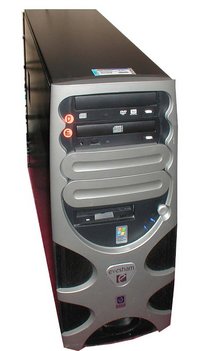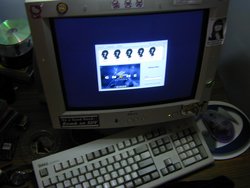Personal computer
|
|

Pc.computer.bristol.750pix.jpg
Martin_Ultima's_Dell.jpg
Martin_Ultima's_Micron.jpg
The term personal computer or PC is generally a microcomputer intended to be used by one person at a time, and suitable for general purpose tasks such as word processing, programming, or game play, usually used to run purchased or other software not written by the user. Unlike minicomputers, a personal computer is often owned by the person using it, indicating a low cost of purchase and simplicity of operation. The user of a modern personal computer may have significant knowledge of the operating environment and application programs, but is not necessarily interested in programming nor even able to write programs for the computer.
The first generation of microcomputers were called just that, and only sold in small numbers to those able to (build them from kits or) operate them: engineers and accomplished hobbyists ( for example, the Altair 8800). The second generation micros were known as home computers, and are discussed in that section.
| Contents |
History
The earliest known use of the term was in New Scientist magazine in 1964, in a series of articles called "The World in 1984". In "The Banishment of Paper Work," Arthur L. Samuel of IBM's Watson Research Center writes, "While it will be entirely feasible to obtain an education at home, via one's own personal computer, human nature will not have changed."
The first computers that can be called 'personal' were the first non-mainframe computers, the LINC and the PDP-8. By today's standards they were big (about the size of a refrigerator), expensive (around $50,000 US), and had small magnetic core memories (about 4096 12-bit words for the LINC).
However, they were small enough and cheap enough for individual laboratories and research projects to use, freeing them from the batch processing and bureaucracy of the typical industrial or university computing center. In addition, they were moderately interactive and soon had their own operating systems. Eventually, this category became known as the mini-computer, usually with time-sharing and program development facilities. Eventually, the mini-computer grew up to encompass the VAX and larger mini-computers from Data General, Prime, and others. Deployment of mini-computer systems was a model for how personal computers would be used, but few of the mini-computer makers managed to profit from it.
Development of the single-chip microprocessor changed everything, since it dropped the cost of purchase of a computer by an order of magnitude or more.
The first generation of microcomputers that started to appear in the mid 1970s (see home computers) were less powerful and in some ways less versatile than business computers of the day (but in other ways more versatile, in terms of built-in sound and graphics capabilities), and were generally used by computer enthusiasts for learning to program, for running simple office/productivity applications, for electronics interfacing, and/or games, as well as for accessing BBS's, general online services such as CompuServe, The Source, or Genie, or platform-specific services such as Quantum Link (US) or Compunet (UK).
It was the launch of the VisiCalc spreadsheet, initially for the Apple II and later for the Atari 8-bit family, Commodore PET, and IBM PC that became the "killer app" that turned the microcomputer into a business tool. Later, Lotus 1-2-3, a combined spreadsheet (partly based on VisiCalc), presentation graphics, and simple database application, became the PCs own killer app. Good word processor programs also appeared for many home computers. The low cost of personal computers led to great popularity in the home and business markets during the 1980s. In 1982, Time magazine named the personal computer its Man of the Year.
During the 1990s, the power of personal computers increased radically, blurring the formerly sharp distinction between personal computers and multi-user computers such as mainframes. Today higher-end computers often distinguish themselves from personal computers by greater reliability or greater ability to multitask, rather than by straight CPU power.
Architecture
Personal computers can be categorized by size and portability:
- the desktop computer
- the portable computer
- the notebook or laptop
- the tablet computer
- the PDA
- the wearable computer
Many mass-market IBM PC compatible and Apple Macintosh personal computers are standardized to the point that purchased software is expected to run with little or no customization for the particular computer. Often memory, and peripherals such as video boards and disk storage are easily upgradable, even by the end user, and even the motherboard can in some cases be changed to upgrade the power of the central processor. Such upgradeability is not indefinite since major changes in the personal computer industry occur every three to five years; a machine that was considered top-of-the-line say five or six years ago may be impractical to upgrade due to changes in processors, memory, and peripherals. This upgrade cycle is in part linked to new releases of the primary mass-market operating system, which tends to drive the accquisition of new hardware and tends to obsolete previously serviceable hardware (see planned obsolescence).
The hardware capabilities of personal computers can sometimes be extended by the addition of expansion cards. The standard expansion bays for personal computers as of 2005 are ISA, PCI and AGP. A PC may also be upgraded by the addition of extra drives (DVD, CD-ROM, flash drive, Hard drive, etc). Standard storage device interfaces are ATA, Serial ATA or SCSI in 2005.
Motherboard
- Main article: PC motherboard
The motherboard is the primary circuit board for a computer. Most other computer components plug directly into the motherboard to allow them to exchange information. Motherboards usually hold a chipset, BIOS, CMOS, parallel port, PS/2 keyboard and mouse ports and expansion bays. Sometimes a secondary daughter board is plugged into the motherboard to provide more expansion bays and to cut down on its size.
Central processing unit
- Main article: central processing unit
The Central processing unit or CPU is the part of the computer that performs most of the calculations that make programs or operating systems run. The CPU plugs directly into the motherboard by one of many different types of sockets. Most IBM PC compatible computers use an x86-compatible processor made by Intel, AMD, VIA Technologies or Transmeta.
RAM - memory
- Main article: random access memory
The Random Access Memory of the computer is the "short-term-memory" of the PC, It is much faster than the mass storage devices like Harddisk or CD-ROM, but its contents are lost when the Power is turned off.
Hard disk drive
- Main article: hard disk
PSU - power supply unit
- Main article: power supply
Essential. Provides steady DC supply from a domestic AC source. Many problems with Old PCs can be traced to a faulty or overheating PSU.
Non-IBM compatible personal computers
Though many personal computers are IBM PC compatible using either Microsoft Windows or open-source forms of UNIX such as Linux, a number of other personal computer types are still popular. The leading alternative is Apple Computer's Power Macintosh platform, based on the PowerPC microprocessor.
Further PC and PW (Personal Workstation) types through time:
- Acorn Archimedes & RiscPC
- Atari ST
- BeOS BeBox
- Amiga (previously produced by Commodore, now under licence from Amiga Inc.)
- Pegasos
- NEC PC-9800 (At one time, in Japan)
- NeXT workstations
- Sun SparcStation
- SGI workstations like the SGI Indigo and SGI Onyx
The term "personal computer" is often avoided by advocates of the above computer systems, ostensibly because of the association it has to the "PC" in "IBM PC".
See also
- Xerox Star
- The Apple, Apple II, Lisa, and Macintosh
- Osborne 1
- 8-bit microcomputer
- Computer case
- Desknote
- History of computing hardware (1960s-present)
- Liquid crystal display television.
- Microcomputer
- Minicomputer
- Mainframe computer
- Supercomputer
- Server
External links
- Old Computers Museum (http://www.old-computers.com/) (all computer types)
- IBM PC (http://www.old-computers.com/museum/computer.asp?c=274) The beginning of the PC: the IBM PC - model 5150.
- Rune's PC Museum (http://pc-museum.com/)
- The PC Guide (http://www.pcguide.com/) contains detailed historical and technical information.
- Howstuffworks' article on "How PCs Work" (http://computer.howstuffworks.com/pc.htm)
- A Month with a Mac: A Die-Hard PC User's Perspective (http://www.anandtech.com/mac/showdoc.aspx?i=2232)
- Wikicity for PC enthuiasm (http://pc.wikicities.com)cs:Osobní počítač
da:Personlig computer de:Personal Computer es:Ordenador personal eo:PC fa:کامپیوتر شخصی fr:Ordinateur personnel ko:개인용 컴퓨터 id:Komputer pribadi (PC) it:Personal computer lt:Asmeninis kompiuteris lv:Personālais dators hu:Személyi számítógép ms:Komputer Peribadi nv:Béésh bee ak'e'elchí Áłtsisígíí nl:Personal computer ja:パーソナルコンピュータ pt:Computador pessoal ru:Персональный компьютер fi:PC sv:Persondator th:คอมพิวเตอร์ส่วนบุคคล tr:PC zh:个人计算机

